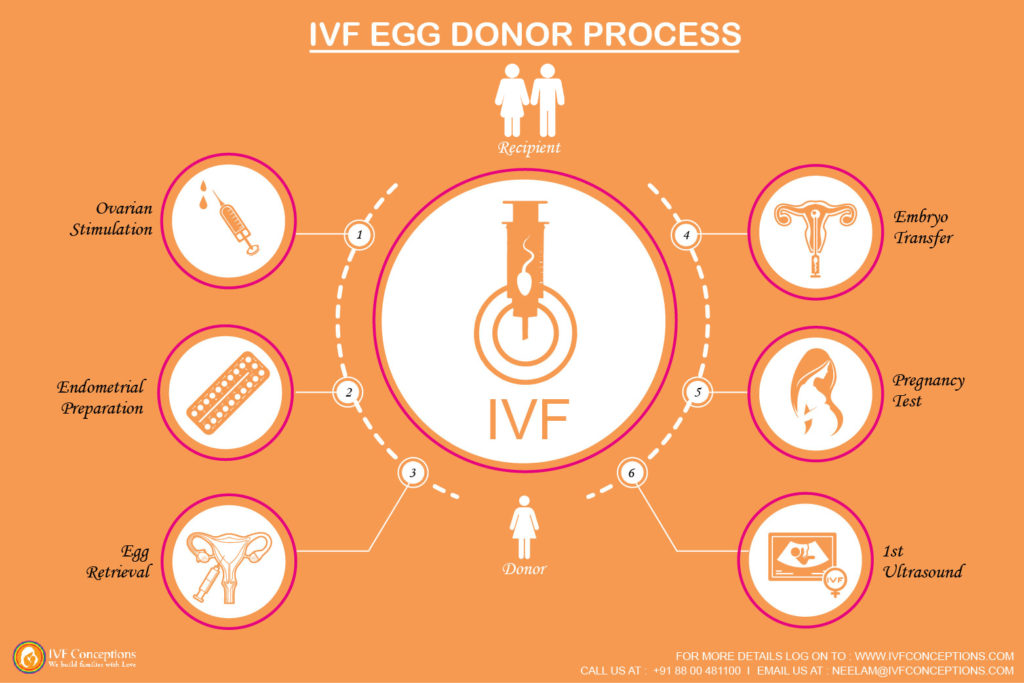IVF Guide For Intended Parents
One out of eight couples struggle to have offspring. Nowadays IVF has become the most widely used infertility treatment in the world and has helped thousands of Intended Parents to fulfill their dream of parenthood. On this page, we will learn about the Intended Parents Surrogacy Guide so that they can make informed decisions.
Any medical intervention that is done to assist a couple to have their own child can be considered an infertility treatment. This can be as simple as receiving advice on the right time of the month to have regular sex, and as complex as a cycle of In-vitro fertilization (IVF).
IVF- Step-by-Step Guide
Every cycle of IVF involves multiple steps, and each occurs at a specific time during a four to six-week period. The following is an overview of the IVF procedure. The procedure begins in the month proceeding with the actual IVF
cycle. An IVF cycle typically includes the following steps:
The more related topic for the gestational surrogacy process
Types of surrogacy and which is best for you?
Which are the best countries for surrogacy?
How long does the surrogacy process take?
How to tell your kids about surrogacy?
15 Things You Should Know About Surrogacy
Things to Know Before Planning For Surrogacy
What Are Indications Of Surrogacy?
Outlines the surrogacy process timeline for gay intended parents:
The surrogacy process takes 18 months to 24 months depending upon the individual circumstances
| Stage | Description of Stage | Duration |
| Research Phase | Explore family-building options and decide on surrogacy. | Personal timeframe |
| Consultation and Application | Choose a surrogacy agency, sign an agreement, and start embryo creation (if needed). | 1-3 Months |
| Matching | The agency finds and presents potential gestational carriers. Meet and decide on a match. | 3-6 Months |
| Medical Screening and Contracts | Carrier undergoes medical and psychological screening. Sign a surrogacy contract. | 1-2 Months |
| Embryo Transfer | Prepare for embryo transfer. Success may take multiple attempts. | 1-1.5 Months |
| Pregnancy | Gestational carrier’s pregnancy, approximately 40 weeks. | 9-10 Months |
| Birth and Postpartum | Baby’s birth, establish parental rights, and the postpartum period. | 1.5-3 Months |
Please keep in mind that the durations mentioned in the table are approximate and can vary depending on individual circumstances and other factors. Always consult with a reputable surrogacy agency or professional to get personalized guidance throughout the surrogacy journey.
Step 1. Suppressing the natural monthly hormone cycle
As a first step of the IVF process, you may be given a drug to suppress your natural cycle. To start this treatment either a daily injection (which is normally self-administered unless you are not able to do this yourself) or a nasal spray is given. This continues for about two weeks.
Step 2. Increasing the Egg Numbers
After the natural cycle is suppressed, you are given a fertility hormone called FSH (or Follicle follicle-stimulating hormone). This is usually taken as a daily injection for around 10 to 12 days. This hormone will increase the number of eggs you produce which means you will have more eggs to be fertilized with semen samples and more embryos for implantation. With more fertilized eggs, the clinic has a greater choice of embryos to use in your treatment.
Step 3. Checking on progress
Throughout the drug treatment, the clinic will monitor your progress. This is done by vaginal ultrasound scans and blood tests. Around 34 to 36 hours before your eggs are due to be collected you have a final hormone trigger to help your eggs mature and subsequently get ready for retrieval.
Step 4. Collecting the eggs/semen sample
In the IVF process eggs are usually collected by ultrasound guidance under local anesthesia. This involves a needle being inserted into the scanning probe and into each ovary, facilitating egg pickup. Sometimes cramping and a small amount of vaginal bleeding can occur after the procedure.
Collecting sperm
Around the same time, a female partner is going through egg collections; the male partner is asked to produce a fresh sample of sperm. This is stored for a short time before the sperms are washed and spun at a high speed. This is so the healthiest and most active sperm can be selected. If you are using donated sperm, it is removed from frozen storage, thawed, and prepared in the same way. Learn more about how to choose an egg donor.
Step 5. Fertilization of eggs with sperms
Your eggs are mixed with your partner or the donor sperm and cultured in the laboratory for 16 to 20 hours. They are then checked to see if any have been fertilized. Those that have been fertilized (now called embryos) are grown in the laboratory incubator for another one to two days before being checked again. Sometimes fertility specialist decides to go ahead with manually assisted fertilization; this process is known as ICSI. Intracytoplasmic Sperm Injection, or ICSI, is a technique in which a single live sperm is injected into the center of a single human egg. This technique is developed to help achieve fertilization for couples with severe male factor infertility or couples who have had failure to fertilize in a previous in vitro fertilization attempt. IVF-ICSI could be one of the best options for the couple struggling with male factor infertility, which includes low sperm count, low number of live sperm, sperm motility, and morphology issues.
More resources to read:
How to manage surrogacy costs?
Pregnancy After Miscarriage: What You Need to Know
LGBT Surrogacy: All You Need to Know to Grow Your Family
How Intended Parents Prepare Themselves For Surrogacy?
Step 6. Embryo Transfers
After fertilization, the best one or two embryos will then be chosen for transfer and with the help of a thin catheter transferred into the uterus of the female partner or recipient. This process is known as embryo transfer and it is relatively simple and does not require any anesthesia. The number of embryos is restricted because of the risks associated with multiple births. The remaining embryos may be frozen for future IVF attempts if they are suitable. Some clinics may also offer blastocyst transfer, where the fertilized eggs are left to mature for five to six days and then transferred. This is known as Blastocyst transfer.
Step 7. Follow-up after Embryos Transfers
After embryo transfer, the recipient is asked to take 2 days of rest and avoid any strenuous activities. You need to take progesterone supplements continuously to support the implantation. Following 12 to 14 days of embryo transfer, blood tests are done to confirm the pregnancy.
Step 8. Follow-up for pregnancy or next attempt
In case a successful pregnancy is confirmed through blood tests, continuous support of hormones is given until 10 weeks to 12 weeks and after that, it can be followed by natural pregnancy. In case, the blood test shows no pregnancy, further options are discussed with you. In case you have frozen embryos stored, you can go ahead with frozen embryo transfer (FET) and for those with no frozen embryos, the cycle needs to be repeated. In case you have continuous failed IVF cycles, your doctor can suggest donor IVF for you.
Sure, here’s the information on international surrogacy laws organized in a table format:
| Country | Eligibility for Surrogacy | Types of Surrogacy Allowed | Legal Protection for Intended Parents | Accessibility for Foreigners | Advertising for Surrogates |
| Australia | Altruistic surrogacy only | No donor or surrogate matching | Not applicable | Not applicable | Not legal |
| Canada | Altruistic surrogacy only | Not applicable | Not applicable | Altruistic surrogacy allowed | Not applicable |
| Greece | Heterosexual couples, single females | Not applicable | Not applicable | Foreign nationals allowed | Not applicable |
| Georgia | Heterosexual couples (including foreigners) | Compensated surrogacy | Well protected | Foreigners allowed | Not applicable |
| Ukraine | Heterosexual couples (including foreigners) | Compensated surrogacy | Well protected | Foreigners allowed | Not applicable |
| India | Indian citizens only | Commercial surrogacy allowed | Not applicable | Not applicable | Not applicable |
| Israel | Heterosexual Israeli citizens | Altruistic surrogacy only | Not applicable | Not applicable | Not applicable |
| Kenya | Locals and foreigners | Compensated surrogacy | Not legally protected | Not applicable | Not applicable |
| Laos | Foreigners only | Compensated surrogacy | Not legally protected | Foreigners allowed | Not applicable |
| Nigeria | Heterosexual Nigerian citizens | Altruistic and commercial surrogacy | Not applicable | Not applicable | Not applicable |
| South Africa | Heterosexual South African residents | Altruistic surrogacy | Not applicable | Not applicable | Not applicable |
| Thailand | Heterosexual Thai couples | Altruistic surrogacy only | Not applicable | Not applicable | Not applicable |
| UK | Not applicable | Altruistic surrogacy only | Not applicable | Foreigners cannot access | Not Legal |
| USA | Gay and heterosexual foreigners | All forms of surrogacy | Well regulated | Foreigners allowed | Not applicable |
Conclusion for Intended Parents Surrogacy Guide
If you’d like to learn more about IVF, Egg Donation, or surrogacy services globally, check out the rest of our website at IVF Conceptions. We offer legally secure and affordable surrogacy consulting services for FREE.
Get in touch now to get started! We recommend sending an email or filling out the forms below to know your best surrogacy options worldwide.
Our surrogacy consultancy is free of cost. We do not charge any fee and make sure that you are well aware of all your options to make an informed decision.


